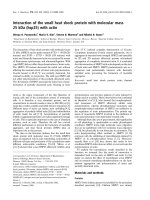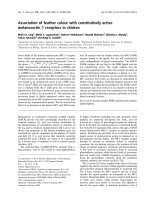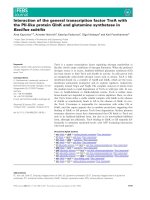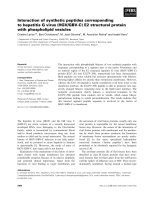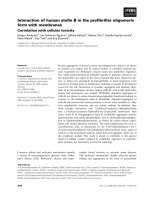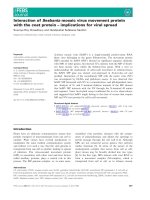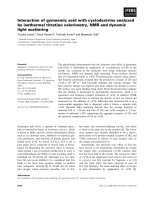báo cáo khoa học: "Interaction of silver nanoparticles with HIV-1" pdf
Bạn đang xem bản rút gọn của tài liệu. Xem và tải ngay bản đầy đủ của tài liệu tại đây (1.43 MB, 10 trang )
BioMed Central
Page 1 of 10
(page number not for citation purposes)
Journal of Nanobiotechnology
Open Access
Research
Interaction of silver nanoparticles with HIV-1
Jose Luis Elechiguerra
1
, Justin L Burt
1
, Jose R Morones
1
, Alejandra Camacho-
Bragado
2
, Xiaoxia Gao
2
, Humberto H Lara
3
and Miguel Jose Yacaman*
1,2
Address:
1
Department of Chemical Engineering, The University of Texas at Austin, Austin, Texas 78712, USA,
2
Texas Materials Institute, The
University of Texas at Austin, Austin, Texas 78712, USA and
3
Facultad de Ciencias Biológicas, Universidad Autónoma de Nuevo León, San Nicolás
de los Garza, Nuevo León, Mexico
Email: Jose Luis Elechiguerra - ; Justin L Burt - ; Jose R Morones - ;
Alejandra Camacho-Bragado - ; Xiaoxia Gao - ;
Humberto H Lara - ; Miguel Jose Yacaman* -
* Corresponding author
Abstract
The interaction of nanoparticles with biomolecules and microorganisms is an expanding field of
research. Within this field, an area that has been largely unexplored is the interaction of metal
nanoparticles with viruses. In this work, we demonstrate that silver nanoparticles undergo a size-
dependent interaction with HIV-1, with nanoparticles exclusively in the range of 1–10 nm attached
to the virus. The regular spatial arrangement of the attached nanoparticles, the center-to-center
distance between nanoparticles, and the fact that the exposed sulfur-bearing residues of the
glycoprotein knobs would be attractive sites for nanoparticle interaction suggest that silver
nanoparticles interact with the HIV-1 virus via preferential binding to the gp120 glycoprotein knobs.
Due to this interaction, silver nanoparticles inhibit the virus from binding to host cells, as
demonstrated in vitro.
Background
Nanotechnology provides the ability to engineer the prop-
erties of materials by controlling their size, and this has
driven research toward a multitude of potential uses for
nanomaterials[1]. In the biological sciences, many appli-
cations for metal nanoparticles are being explored, includ-
ing biosensors[2], labels for cells and biomolecules[3],
and cancer therapeutics[4].
It has been demonstrated that, in the case of noble-metal
nanocrystals, the electromagnetic, optical and catalytic
properties are highly influenced by shape and size [5-7].
This has driven the development of synthesis routes that
allow a better control of morphology and size [8-13].
Noble-metal nanomaterials have been synthesized using
a variety of methods, including hard-template[14], bio-
reduction[9] and solution phase syntheses[8,10-13].
Among noble-metal nanomaterials, silver nanoparticles
have received considerable attention due to their attrac-
tive physicochemical properties. The surface plasmon res-
onance and large effective scattering cross section of
individual silver nanoparticles make them ideal candi-
dates for molecular labeling[15], where phenomena such
as surface enhance Raman scattering (SERS) can be
exploited. In addition, the strong toxicity that silver exhib-
its in various chemical forms to a wide range of microor-
ganisms is very well known [16-18], and silver
nanoparticles have recently been shown to be a promising
antimicrobial material[19].
Published: 29 June 2005
Journal of Nanobiotechnology 2005, 3:6 doi:10.1186/1477-3155-3-6
Received: 28 March 2005
Accepted: 29 June 2005
This article is available from: />© 2005 Elechiguerra et al; licensee BioMed Central Ltd.
This is an Open Access article distributed under the terms of the Creative Commons Attribution License ( />),
which permits unrestricted use, distribution, and reproduction in any medium, provided the original work is properly cited.
Journal of Nanobiotechnology 2005, 3:6 />Page 2 of 10
(page number not for citation purposes)
For these reasons, and based upon our previous work
regarding interactions of noble metal nanoparticles with
biomolecules[20], we decided to study the interaction of
silver nanoparticles with viruses. Herein, we present the
first findings of our investigation, the discovery that silver
nanoparticles undergo size-dependent interaction with
HIV-1.
Findings
Characterization of the tested silver nanoparticle
preparations
The physicochemical properties of nanoparticles are
strongly dependent upon their interactions with capping
agent molecules[21]. Indeed, the surface chemistry of the
nanoparticles can modify their interactions with external
systems. For this reason we tested silver nanoparticles
with three markedly different surface chemistries: foamy
carbon, poly (N-vinyl-2-pyrrolidone) (PVP), and bovine
serum albumin (BSA).
Foamy carbon-coated nanoparticles were obtained from
Nanotechnologies, Inc., and used without further treat-
ment. These nanoparticles are embedded in a foamy car-
bon matrix which prevents coalescence during their
synthesis. The as-received nanoparticle sample consists of
a fine black powder. For the purposes of the present work,
the as-received powder was dispersed in deionized water
by ultra-sonication. TEM analysis shows that the nanopar-
ticles tend to be agglomerated inside the foamy carbon
matrix, although a significant fraction of the population is
released from this matrix by the energy provided from the
ultra-sonic bath (Figure 1a–1f). These released nanoparti-
cles are mainly free-surface nanoparticles, and it was
observed that only nanoparticles that have escaped from
the foamy carbon matrix interact with the HIV-1 cells.
The interaction of the nanoparticles with the foamy car-
bon matrix is sufficiently weak that simply by condensing
the TEM electron beam, even those nanoparticles that
were not initially released by ultra-sonication are ejected
from the foamy carbon agglomeration. In fact, after this
experiment the complete size distribution of these nano-
particles is better observed, please refer to Additional file:
1. High resolution transmission electron microscopy
(TEM) revealed that the silver nanoparticles released from
the foamy carbon matrix by ultrasonication have a size
distribution of 16.19 ± 8.68 nm (Figure 2a–b). By releas-
ing the remaining nanoparticles from the foamy carbon
matrix with the action of the electron beam, the average
size was ~21 ± 18 nm. Additionally, TEM examination
demonstrated that the sample is composed of several
morphologies including multi-twinned nanoparticles
with five-fold symmetry, i.e. decahedra and icosahedra,
truncated pyramids, octahedral and cuboctahedral nano-
particles, among others (Figure 1c–1f).
PVP-coated nanoparticles were synthesized by the polyol
method using glycerine as both reducing agent and sol-
vent. In this method, a metal precursor is dissolved in a
liquid polyol in the presence of a capping agent such as
PVP[22]. PVP is a linear polymer and stabilizes the nano-
particle surface via bonding with the pyrrolidone ring.
Infrared (IR) and X-ray photoelectron spectroscopy (XPS)
studies have revealed that both oxygen and nitrogen
atoms of the pyrrolidone ring can promote the adsorption
of PVP chains onto the surface of silver[23]. The sample
size distribution was obtained from high angle annular
dark field (HAADF) images. The nanoparticles exhibited
an average size of 6.53 nm with a standard deviation of
2.41 nm. (Figure 2d–e)
Silver nanoparticles directly conjugated to BSA protein
molecules were synthesized in aqueous solution. Serum
albumin is a globular protein, and is the most-abundant
protein in blood plasma. Bovine serum albumin (BSA) is
Transmission electron microscopy (TEM) of the foamy car-bon-coated silver nanoparticlesFigure 1
Transmission electron microscopy (TEM) of the
foamy carbon-coated silver nanoparticles. a) TEM
image of the sample prepared by dispersing the as-received
powder in deionized water by ultra-sonication. The agglom-
eration of particles inside the foamy carbon matrix is
observed. b) TEM image of nanoparticles outside of the car-
bon matrix. The broad distribution of shapes can be
observed. c)-f) TEM images of nanoparticles with different
morphologies. c) Icosahedral. d) Decahedral. e) Elongated. f)
Octahedral. g) High Resolution TEM image of the foamy car-
bon matrix.
Journal of Nanobiotechnology 2005, 3:6 />Page 3 of 10
(page number not for citation purposes)
a single polypeptide chain composed of 583 amino acid
residues [24]. Several residues of BSA have sulfur-, oxygen-
, and nitrogen-bearing groups that can stabilize the nano-
particle surface. The strongest interactions with silver
likely involve the 35 thiol-bearing cysteine residues. By
using sodium borohydride, a strong reducing agent, BSA
stabilizes nanoparticles via direct bonding with these
thiol-bearing cysteine residues, and provides steric protec-
Silver nanoparticle preparationsFigure 2
Silver nanoparticle preparations. a) TEM image of free surface silver nanoparticles released from the foamy carbon matrix
by dispersing the as-received powder in deionized water by ultra-sonication. b) Size distribution of free surface nanoparticles
measured by TEM analysis. c) UV-Visible spectrum of carbon-coated silver nanoparticles. d) HAADF image of PVP-coated sil-
ver nanoparticles. e) Size distribution of PVP-coated nanoparticles measured by TEM analysis. f) UV-Visible spectrum of PVP-
coated silver nanoparticles. g) HAADF image of BSA-coated silver nanoparticles. h) Size distribution of BSA-coated nanoparti-
cles measured by TEM analysis. i) UV-Visible spectrum of BSA-coated silver nanoparticles.
Journal of Nanobiotechnology 2005, 3:6 />Page 4 of 10
(page number not for citation purposes)
tion due to the bulkiness of the protein. The sample size
distribution was obtained from HAADF images. Nearly
75% of the BSA-conjugated silver nanoparticles were 2.08
± 0.42 nm in diameter, but a substantial fraction of larger
particles was also observed, bringing the total average to
3.12 ± 2.00 nm (Figure 2g–h).
UV-visible spectroscopy is a valuable tool for structural
characterization of silver nanoparticles. It is well known
that the optical absorption spectra of metal nanoparticles
are dominated by surface plasmon resonances (SPR),
which shift to longer wavelengths with increasing particle
size [25]. Also, it is well recognized that the absorbance of
silver nanoparticles depends mainly upon size and shape
[26,27]. In general, the number of SPR peaks decrease as
the symmetry of the nanoparticle increases [27]. Recently,
Schultz and coworkers[28] correlated the absorption spec-
tra of individual silver nanoparticles with their size (40–
120 nm) and shape (spheres, decahedrons, triangular
truncated pyramids and platelets) determined by TEM.
They found that spherical and roughly spherical nanopar-
ticles, decahedral or pentagonal nanoparticles, and trian-
gular truncated pyramids and platelets absorb in the blue,
green and red part of the spectrum, respectively. In all the
cases the SPR peak wavelength increases with size, as
expected.
The UV-Visible spectra for all the nanoparticle prepara-
tions are shown in Figure 2. All samples presented a min-
imum at ~320 nm that corresponds to the wavelength at
which the real and imaginary parts of the dielectric func-
tion of silver almost vanish [27]. The sample with carbon-
coated silver nanoparticles exhibits four peaks at ~400,
~490, ~560 and ~680 nm, as shown in Figure 2c. The opti-
cal signature of this sample can be better understood in
terms of the distribution of sizes and shapes observed in
the TEM. As we previously mentioned, the distribution of
shapes in the sample is broad, and a significant amount of
nanoparticles are not spherical such as multi-twinned
with five-fold symmetries. The presence of nanoparticles
with pentagonal and triangular cross-sections could be
responsible for the absorption at longer wavelengths.
Thus, it is clear that the characteristic absorption of these
nanoparticles arises from the contribution of different
shapes and sizes, which agrees with the TEM observations.
On the other hand, the PVP-coated and BSA-coated silver
nanoparticles present only one peak at ~450 and ~390
nm, respectively. These results indicate that both prepara-
tions are mainly composed by small spherical silver nan-
oparticles. It is also well know that for small particles a
broadening of the plasmon absorption bands is expected,
since there is a linear dependence of the full-width at half
maximum (FWHM) with the reciprocal of the particle
diameter[29]. The results for BSA-coated nanoparticles
agree with the last statement, presenting just one broad
symmetric peak at ~390 nm. On the other hand, the spec-
trum for the PVP-coated silver nanoparticles is not sym-
metric around the maximum absorption wavelength. In
fact, this spectrum can be deconvoluted in two different
curves, one centered at ~430 and another one at ~520 nm.
The peak at ~430 nm could be assigned to the out-of-
plane dipole resonance of the silver nanoparticles indicat-
ing the presence of spherical particles with small diame-
ters. In addition, the synthesis of silver nanoparticles by
the polyol method in presence of PVP promotes also the
formation of multi-twinned nanoparticles (MTPs), being
decahedra nanoparticles the most thermodynamically sta-
ble MTPs [23]. Therefore, the observed read shift is a con-
sequence of both nanoparticles of larger size and the
presence of decahedral nanoparticles with pentagonal
cross sections.
Interaction with HIV-1
High angle annular dark field (HAADF) scanning trans-
mission electron microscopy was employed to study the
interaction of silver nanoparticles with HIV-1. In our pre-
vious works, HAADF has proven to be a powerful tech-
nique for analysis of biological samples, such as
proteins[20] and bacteria[30], interfaced with inorganic
nanoparticles. HAADF images are primarily formed by
electrons that have undergone Rutherford backscattering.
As a result, image contrast is related to differences in
atomic number [31] with intensity varying as ~Z
2
. There-
fore, image contrast is strongly related to composition. As
a good approximation, lighter elements appear dark and
heavier elements appear bright. Due to a large difference
in atomic number, silver nanoparticles are easily distin-
guished from the organic matter that composes the virus.
In Figure 3, we present HAADF images of the HIV-1 virus
with (3a) and without (3b) silver nanoparticles. For com-
plete experimental details, refer to Methods Section. The
presence of silver was independently confirmed by Energy
Dispersive X-ray Spectroscopy (EDS), shown in Figure 3c.
Interestingly, the sizes of nanoparticles bound to the virus
(Figure 3d) were exclusively within the range of 1–10 nm.
In the case of the silver nanoparticles released from the
carbon matrix, the fact that no nanoparticles greater than
10 nm in diameter were observed to interact with the virus
is significant, since the size of ~40% of the overall popu-
lation is beyond this range. This provides strong evidence
for the size-dependence of interaction.
Additionally, the nanoparticles seen in Figure 3a are not
randomly attached to the virus, as regular spatial relation-
ships are observed among groups of three particles. Both
the spatial arrangement of nanoparticles and the size
dependence of interaction can be explained in terms of
Journal of Nanobiotechnology 2005, 3:6 />Page 5 of 10
(page number not for citation purposes)
HAADF images of the HIV-1 virusFigure 3
HAADF images of the HIV-1 virus. a) HAADF image of an HIV-1 virus exposed to BSA-conjugated silver nanoparticles.
Inset shows the regular spatial arrangement between groups of three nanoparticles. b) HAADF image of HIV-1 viruses without
silver nanoparticle treatment. Inset highlight the regular spatial arrangement observed on the surface of the untreated HIV-1
virus. c) EDS analysis of image a) confirming the presence of Ag. The C signal comes from both the TEM grid and the virus, O,
and P are from the virus, and Na, Cl, and K are present in the culture medium. Ni and Si come from the TEM grid, while Cu is
attributed to the sample holder. d) Composite size distribution of silver nanoparticles bound to the HIV-1 virus, derived from
all tested preparations.
Journal of Nanobiotechnology 2005, 3:6 />Page 6 of 10
(page number not for citation purposes)
the HIV-1 viral envelope, and can provide insight into the
mode of interaction between the virus and nanoparticles.
The exterior of the HIV-1 virus is comprised of a lipid
membrane interspersed with protruding glycoprotein
knobs, formed by trimers consisting of two subunits: the
gp120 surface glycoprotein subunit is exposed to the
exterior, and the gp41 transmembrane glycoprotein subu-
nit spans the viral membrane and connects the exterior
gp120 glycoprotein with the interior p17 matrix pro-
tein[32]. The main function of these protruding gp120
glycoprotein knobs is to bind with CD4 receptor sites on
host cells. Numerous cellular proteins are also embedded
within the viral envelope[33]. However, the protruding
gp120 glycoprotein knobs are more exposed to the exte-
rior, and should be more accessible for potential nanopar-
ticle interactions.
Leonard and coworkers[34] reported that the gp120 sub-
unit has nine disulfide bonds, three of which are located
in the vicinity of the CD4 binding domain. These exposed
disulfide bonds would be the most attractive sites for nan-
oparticles to interact with the virus. As mentioned previ-
ously, the nanoparticles in Figure 1a appear to be located
at specific positions, with regular spatial relationships
observed among groups of three particles. The observed
spatial arrangements correlate with the positions of the
gp120 glycoprotein knobs in the structural model for
HIV-1 proposed by Nermut and coworkers[32].
Regular spatial relationships are also found on the surface
of the untreated virus, as seen in the inset of Figure 1b. The
observed darker contrast at these sites could indicate the
locations of the glycoprotein knobs. As mentioned previ-
ously, contrast in HAADF images is strongly dependent on
differences in atomic number. However, this is not the
only factor in determining the image contrast. If the mate-
rial is composed of elements of similar atomic numbers,
as is the case for the organic constituents of the pure virus,
local variations in sample density will provide noticeable
contrast. The majority of the viral envelope consists of a
densely-packed lipid membrane. However, for the glyco-
protein knobs, we would expect a localized region of
lower density due to the presence of membrane-spanning
gp41 glycoproteins rather than the densely-packed lipids.
Hence, these areas should appear darker than the rest of
the viral envelope.
It has previously been determined that the center-to-
center spacing between glycoprotein knobs is ~22
nm[35]. In the inset of Figure 3a, the average measured
center-to-center spacing between silver nanoparticles is
~28 nm, which correlates with the expected spacing
between glycoprotein knobs. The average center-to-center
spacing between the small darker regions on the untreated
virus is ~22 nm, which again suggests these sites are the
gp120 glycoprotein knobs. Thus, the observed spatial
arrangement of nanoparticles, the center-to-center dis-
tance between nanoparticles, and the fact that the exposed
sulfur-bearing residues of the glycoprotein knobs would
be attractive sites for nanoparticle interaction strongly
suggest that silver nanoparticles interact with the HIV-1
virus via preferential binding to the gp120 glycoprotein
knobs.
Presuming that the most attractive sites for interaction are
the sulfur-bearing residues of the gp120 glycoprotein
knobs, there are only a limited number of bonds that a
nanoparticle can form. This limited number of stabilizing
sites can explain why larger nanoparticles are not
observed to attach to the virus. Assuming that each nano-
particle interacts with a single glycoprotein knob, and that
each nearest-neighbor knob is occupied by another
nanoparticle, from geometric considerations the theoreti-
cal upper limit for the diameter for these nanoparticles
would be ~20 nm. However, if a nanoparticle larger than
the diameter of one knob (~14 nm[35]) were to be
attached, only a small fraction of the total nanoparticle
surface would be anchored, resulting in a less stable inter-
action. Thus, if the nanoparticles are interacting with HIV-
1 via preferential binding at gp120 glycoprotein knobs,
we would expect to find mostly nanoparticles less than 14
nm in diameter, as particles in this size range would have
the most stable surface interactions. This corresponds
closely with our experimental observation that particles
greater than 10 nm were not attached to the viral
envelope.
Although the mechanism by which HIV infects host cells
is not yet fully understood, there are two steps that are
broadly agreed to be critical. The first step involves bind-
ing of gp120 to the CD4 receptor site on the host cell.
Then, upon binding to CD4, a conformational change is
induced in gp120, resulting in exposure of new binding
sites for a chemokine receptor, i.e. CCR5 or CXCR4 [36-
38]. An agent that preferentially interacts with the gp120
glycoprotein would block the virus from binding with
host cells. Therefore, we measured the inhibitory effects of
silver nanoparticles against HIV-1 in vitro.
The capacity of silver nanoparticles to inhibit HIV-1 infec-
tivity was determined by testing against CD4+ MT-2 cells
and cMAGI HIV-1 reporter cells. For complete experimen-
tal details, refer to Methods Section. The cytopathic effects
of CD4+ MT-2 infection were analysed by optical micros-
copy assessment of syncytium formation as described
elsewhere[39,40], as well as by the HIV-1 infection of
cMAGI cells using the Blue Cell Assay[41,42]. The cytotox-
icity of all the nanoparticle preparations against MT-2
cells was determined using the Trypan Blue exclusion
Journal of Nanobiotechnology 2005, 3:6 />Page 7 of 10
(page number not for citation purposes)
assay [43]. For all three nanoparticle preparations, at sil-
ver concentrations above 25 µg/mL, viral infectivity was
reduced to an extent that it could not be detected by syn-
cytium formation, as shown graphically in Figure 4. For
each nanoparticle preparation, we found a dose-depend-
ant inhibition of HIV-1 infectivity, with an IC
50
where
only moderate cell toxicity was observed, as seen in Figure
4.
Although the findings regarding interaction with HIV-1
were congruent among nanoparticles with markedly dif-
ferent surface chemistry, the toxicity and inhibition results
were not the same. The differences in the observed trends
in HIV-1 inhibition can be explained in terms of the cap-
ping agents employed for each nanoparticle preparation.
BSA- and PVP-protected nanoparticles exhibit slightly
lower inhibition because the nanoparticle surface is
directly bound to and encapsulated by the capping agent.
In contrast, the silver nanoparticles released from the car-
bon matrix have a greater inhibitory effect due to their
essentially free surface area. The fact that the carbon-
coated nanoparticles present higher cytotoxicity can also
be explained in terms of surface chemistry. Since a signif-
icant amount of these silver nanoparticles possess nearly
Inhibition of HIV-1 and toxicity dataFigure 4
Inhibition of HIV-1 and toxicity data. a) Assessment of HIV-1 mediated syncytium formation in MT-2 cells. b) Percentage
of HIV-1 transmission in cMAGI cells. The toxicity of the nanoparticle preparations against MT-2 cells was determined using
the Trypan Blue exclusion assay. The samples were incubated at 37°C, and the cells were evaluated via optical microscopy
after c) 3 h and d) 24 h of exposure to silver nanoparticles.
Journal of Nanobiotechnology 2005, 3:6 />Page 8 of 10
(page number not for citation purposes)
free surfaces, they are able to interact stronger with the
host cells, thus increasing their toxicity. Clearly, selection
of capping agents will be crucial for future research on the
interaction of nanoparticles with viruses, microorgan-
isms, and more complex biosystems, and many more var-
iables require further testing, including the long-term
effects of the presence of nanoparticles, and the impact of
traces of precursor molecules and reaction by-products.
In conclusion, we have found that silver nanoparticles
undergo size-dependent interaction with HIV-1, and that
the bound particles exhibit regular spatial relationships.
These observations lead us to suggest that the nanoparti-
cles undergo preferential binding with the gp120 subunit
of the viral envelope glycoprotein. Silver nanoparticles
inhibit the HIV-1 virus infectivity in vitro, which also sup-
ports our proposal regarding preferential interaction with
gp120. These findings only provide indirect evidence for
our proposed mode of interaction, and we are currently
undertaking testing to determine conclusively if direct
conjugation between gp120 and silver nanoparticles exist.
The interactions of inorganic nanoparticles with biosys-
tems are just beginning to be understood, and potential
applications are being discovered at an increasing rate.
However, in order to realize the future promise of nano-
science, it is imperative that the toxicity and long-term
health effects of exposure to nanomaterials be fully
explored. The flexibility of nanoparticle preparation
methods, the multitude of functionalization techniques,
and facile incorporation of nanoparticles into a variety of
media provide the incentive for further research on the
interaction of metal nanoparticles with viruses.
Methods
a) HIV-1 strains and cell lines
HIV-1
IIIB
laboratory strain of HIV-1 an X4 wild type (wt)
virus was obtained through the AIDS Research and Refer-
ence Reagent Program, Division of AIDS, NIAID, NIH.
CD4+ MT-2 cell line was obtained from the American
Type Culture Collection. The cMAGI HIV-1 reporter cells
were a generous gift from Dr. Phalguni Gupta from the
University of Pittsburgh. All other reagents used were of
the highest quality available.
cMAGI cells were cultured in DMEM Dulbecco's Modified
Eagle Medium (DMEM) (1X) liquid without sodium
phosphate and sodium pyruvate. The medium contained
4,500 mg/L D-glucose and L-glutamine (Invitrogen, Pais-
ley, UK), with 10% fetal calf serum (FCS), 0.2 mg/mL
geneticin (G418), and 0.1 µg/mL puromycin. MT-2 cells
were cultured in RPMI 1640, containing 10% fetal calf
serum (FCS) and antibiotics.
HIV-1
IIIB
primary clinical isolates were propagated by sub-
culture in MT-2 and cMAGI cells. HIV-1
IIIB
was reproduced
according to the DAIDS Virology Manual for HIV Labora-
tories, version 1997, compiled by Division of AIDS of the
National Institute of Allergies and Infectious Diseases and
the National Institute of Health, and Collaborators.
Aliquots of cell-free culture viral supernatants were used
as viral inocula.
All the work related to HIV-1 cells, except for TEM analy-
sis, was done in a Biosafety Level 3 (BSL-3) Laboratory.
b) Synthesis of the three different silver nanoparticle
preparations
Carbon coated silver nanoparticles tested in this study
were obtained from Nanotechnologies, Inc. and used
without further treatment. For more information about
the synthesis of these nanoparticles, please visit http://
www.nanoscale.com
PVP-coated silver nanoparticles were synthesized by the
polyol method using glycerine as both reducing agent and
solvent. Silver sulfate (Ag
2
SO
4
, reagent grade) and poly
(N-vinyl-2-pyrrolidone) (PVP-K30, MW = 40,000) were
purchased from Sigma Aldrich and 1,2,3-Propanetriol
(Glycerin, >99%) was purchased from Fischer Chemicals,
all the materials were used without any further treatment.
Briefly, we added 0.2 g of PVP to a round bottom flask fol-
lowing by the addition of 30 mL of glycerin. Once PVP
was dissolved, we increased the temperature to 140°C.
After 30 minutes we added 2 mL of 0.015 M Ag
2
SO
4
and
left to react for 1 h.
Silver nanoparticles directly conjugated to bovine serum
albumin (BSA) protein molecules were produced as fol-
lowing described. Silver nitrate (AgNO
3
, 0.945 M),
sodium borohydride (NaBH
4
, 99%) and 200 proof spec-
trophotometric-grade ethanol were purchased from
Aldrich. Bovine serum albumin (BSA) was purchased
from Fisher and was used without further treatment.
Briefly, sodium borohydride was added to an aqueous
solution of silver nitrate and BSA under vigorous stirring.
The molar ratio of Ag
+
:BSA was 28:1, and the molar ratio
of Ag
+
:BH4
-
was 1:1. The reaction volume was 40 mL, and
contained 13.50 µmol BSA. The reaction was allowed to
proceed for 1 h, and the product was purified by precipi-
tation at -5°C, followed by cold ethanol filtration.
c) Characterization of the different silver nanoparticle
preparations
Transmission electron microscope was conducted in a
HRTEM JEOL 2010F microscope equipped with Schottky-
type field emission gun, ultra-high resolution pole piece
(Cs = 0.5 mm), and a scanning transmission electron
microscope (STEM) unit with high angle annular dark
Journal of Nanobiotechnology 2005, 3:6 />Page 9 of 10
(page number not for citation purposes)
field (HAADF) detector operating at 200 kV. Briefly, a
droplet of each different solution of silver nanoparticles
was placed on a Cu grid with lacey carbon film (Ted
Pella), and allowed to evaporate. Size distributions for
each nanoparticle preparation were obtained from TEM
analysis based on the measurement of 400 particles, and
600 particles in the case of BSA-coated nanoparticles.
UV-visible spectra were obtained at room temperature
using a 10 mm path length quartz cuvette in a Cary 5000
spectrometer. All the solutions were diluted 30 × in deion-
ized water before acquiring the spectra.
d) Electron microscopy of HIV-1 and silver nanoparticles
Samples were prepared for electron microscopy as fol-
lows: 10
5
TCID
50
samples of HIV-1
IIIB
cell free virus were
treated with solutions of the different silver nanoparticles
at a concentration of 100 µg/mL. After 30 seconds, a 10 µL
droplet was deposit on a carbon coated nickel TEM grid
and exposed to a 2.5% solution of PBS/glutaraldehyde
vapors for 30 minutes. Microscopy was done using a JEOL
2010-F TEM equipped with an Oxford EDS unit, at an
accelerating voltage of 200 kV and operated in scanning
mode using an HAADF detector.
e) Inhibition of HIV-1 with silver nanoparticles
RPMI medium only or containing varying concentrations
of silver nanoparticles were mixed with samples 10
5
TCID
50
of HIV-1
IIIB
cell free virus. The highest concentra-
tion of silver nanoparticles used was 100 µg/mL. After 30
seconds, sequential 2-fold dilutions of the solutions were
added to cultures of target cells (2 × 10
5
MT-2 and 2 × 10
5
cMAGI HIV-1 reporter cells with 0.2–0.5 multiplicity of
infection (m.o.i) of HIV-1
IIIB
virus) prepared as previously
mentioned. Each dilution was exposed to four replicate
wells. After that, the cells were incubated in a 5% CO
2
humidified incubator at 37°C for 3–5 days. Assessment of
HIV-1 mediated syncytium formation was performed for
the MT-2 cells, while for cMAGI cells, the percentage of
transmission was estimated as follows: the number of
blue-stained cells obtained from the supernatant of each
of the tested wells was divided by the number of blue-
stained cells obtained from the culture supernatant in the
well of the positive control.
f) Cytotoxicity of silver nanoparticles against MT-2 cells
The cytotoxicity of the nanoparticle preparations against
MT-2 cells was determined using the Trypan Blue exclu-
sion assay. In all cases, the initial concentration of silver
nanoparticles was 50 µg/mL and sequential two-fold dilu-
tions were made and mixed with 2 × 10
5
MT-2 cells. The
samples were incubated at 37°C, and the cells were eval-
uated via optical microscopy after 3 h and 24 h of expo-
sure to silver nanoparticles. Briefly, an aliquot of the cell
suspension was diluted 1:1 (v/v) with 0.4% Trypan Blue
and the cells were counted using a haemocytometer. Via-
bility was expressed as the percentage of number of
unstained treated cells to that of the total number of cells.
Additional material
Acknowledgements
The authors want to thank Nanotechnologies, Inc. for providing their silver
nanoparticles. J. L. Elechiguerra, J. R. Morones, and A. Camacho-Bragado
acknowledge the support received from CONACYT- México. J.L.Burt
thanks the University of Texas at Austin College of Engineering and Mr.
Robert L. Mitchell for their financial support through the Thrust 2000 Rob-
ert L. and Jane G. Mitchell Endowed Graduate Fellowship in Engineering.
This material is based upon work supported under a National Science
Foundation Graduate Research Fellowship (to JLB).
References
1. Bonnemann H, Richards RM: Nanoscopic metal particles- Syn-
thetic methods and potential applications. Eur J Inorg Chem
2001, 10:2455-2480.
2. Nam JM, Thaxton CS, Mirkin CA: Nanoparticle-based bio-bar
codes for the ultrasensitive detection of proteins. Science
2003, 301:1884-1886.
3. Tkachenko AG, Xie H, Coleman D, Glomm W, Ryan J, Anderson MF,
Franzen S, Feldheim DL: Multifunctional Gold Nanoparticle-
Peptide Complexes for Nuclear Targeting. J Am Chem Soc
2003, 125:4700-4701.
4. Hirsch LR, Stafford RJ, Bankson JA, Sershen SR, Rivera B, Price RE,
Hazle JD, Halas NJ, West JL: Nanoshell-mediated near-infrared
thermal therapy of tumors under magnetic resonance
guidance. PNAS 2003, 100:13549-13554.
5. Liz-Marzan LM: Nanometals: Formation and color. Materials
Today 2004, 7:26-31.
6. Mulvaney P: Surface Plasmon Spectroscopy of Nanosized
Metal Particles. Langmuir 1996, 12:788-800.
7. Burda C, Chen X, Narayanan R, El-Sayed MA: Chemistry and
Properties of Nanocrystals of Different Shapes. Chemical
Reviews (Washington, DC, United States) 2005, 105:1025-1102.
8. Yu YY, Chang SS, Lee CL, Wang CRC: Gold nanorods: electro-
chemical synthesis and optical properties. Journal of Physical
Chemistry B 1997, 101:6661-6664.
9. Canizal G, Ascencio JA, Gardea-Torresday J, Jose-Yacaman M: Multi-
ple twinned gold nanorods grown by bio-reduction
techniques. Journal of Nanoparticle Research 2001, 3:475-481.
10. Jana NR, Gearheart L, Murphy CJ: Seed-mediated growth
approach for shape-controlled synthesis of spheroidal and
rod-like gold nanoparticles using a surfactant template.
Advanced Materials (Weinheim, Germany) 2001, 13:1389-1393.
11. Jana NR, Gearheart L, Murphy CJ: Wet chemical synthesis of high
aspect ratio cylindrical gold nanorods. Journal of Physical Chem-
istry B 2001, 105:4065-4067.
12. Sun Y, Mayers B, Herricks T, Xia Y: Polyol Synthesis of Uniform
Silver Nanowires: A Plausible Growth Mechanism and the
Supporting Evidence. Nano Letters 2003, 3:955-960.
13. Lisiecki I, Filankembo A, Sack-Kongehl H, Weiss K, Pileni MP, Urban
J: Structural investigations of copper nanorods by high-reso-
lution TEM. Physical Review B: Condensed Matter and Materials Physics
2000, 61:4968-4974.
Additional File 1
Supporting information. The file is a word document that contains the
complete size distribution of the carbon-coated silver nanoparticles evalu-
ated by TEM
Click here for file
[ />3155-3-6-S1.doc]
Publish with BioMed Central and every
scientist can read your work free of charge
"BioMed Central will be the most significant development for
disseminating the results of biomedical research in our lifetime."
Sir Paul Nurse, Cancer Research UK
Your research papers will be:
available free of charge to the entire biomedical community
peer reviewed and published immediately upon acceptance
cited in PubMed and archived on PubMed Central
yours — you keep the copyright
Submit your manuscript here:
/>BioMedcentral
Journal of Nanobiotechnology 2005, 3:6 />Page 10 of 10
(page number not for citation purposes)
14. Zhou Y, Yu SH, Cui XP, Wang CY, Chen ZY: Formation of Silver
Nanowires by a Novel Solid-Liquid Phase Arc Discharge
Method. Chemistry of Materials 1999, 11:545-546.
15. Schultz S, Smith DR, Mock JJ, Schultz DA: Single-target molecule
detection with nonbleaching multicolor optical immunola-
bels. Proceedings of the National Academy of Sciences of the United
States of America FIELD Publication Date:2000 Feb 1 97:996-1001.
FIELD Reference Number: FIELD Journal Code:7505876 FIELD Call
Number:.
16. Liau SY, Read DC, Pugh WJ, Furr JR, Russell AD: Interaction of sil-
ver nitrate with readily identifiable groups: ralationship to
the antibacterial action of silver ions. Lett Appl Microbiol 1997,
25:279-283.
17. Gupta A, Silver S: Silver as biocide:Will resistance become a
problem? Nat Biotechnol 1998, 16:888.
18. Nomiya K, Yoshizawa A, Tsukagoshi K, Kasuga NC, Hirakawa S,
Watanabe J: Synthesis and structural characterization of silver
(I), aluminium (III) and cobalt(II) complexes with 4-isopro-
pyltropolone (hinokitiol) showing noteworthy biological
activities. Action of silver(I)-oxygen bonding complexes on
the antimicrobial activities. J Inorg Biochem 2004, 98:46-60.
19. Sondi I, Salopek-Sondi B: Silver nanoparticles as antimicrobial
agent: A case study on E. coli as a model for Gram-negative
bacteria. J Colloid Interface Sci 2004, 275:177-182.
20. Burt JL, Gutierrez-Wing C, Miki-Yoshida M, Jose-Yacaman MJ:
Noble-Metal Nanoparticles Directly Conjugated to Globular
Proteins. Langmuir 2004, 20:11778-11783.
21. Bradley JS: Clusters and Colloids: From Theory to Applica-
tions. In Clusters and Colloids: From Theory to Applications Edited by:
Schmid GE. Weinheim, VCH; 1994:459-536.
22. Bonet F, Guery C, Guyomard D, Urbina RH, Tekaia-Elhsissen K,
Tarascon JM: Electrochemical reduction of noble metal com-
pounds in ethylene glycol. International Journal of Inorganic
Materials 1999, 1:47-51.
23. Wiley B, Sun Y, Mayers B, Xia Y: Shape-controlled synthesis of
metal nanostructures: The case of silver. Chemistry - A European
Journal 2005, 11:454-463.
24. Peters TJ: All About Albumin: Biochemistry, Genetics, and
Medical Applications. In All About Albumin: Biochemistry, Genetics,
and Medical Applications San Diego, Academic Press; 1996:9-75.
25. Brause R, Moeltgen H, Kleinermanns K: Characterization of laser-
ablated and chemically reduced silver colloids in aqueous
solution by UV/VIS spectroscopy and STM/SEM microscopy.
Applied Physics B: Lasers and Optics 2002, 75:711-716.
26. Kerker M: The optics of colloidal silver: something old and
something new. Journal of Colloid and Interface Science 1985,
105:297-314.
27. Sosa IO, Noguez C, Barrera RG: Optical Properties of Metal
Nanoparticles with Arbitrary Shapes. Journal of Physical Chemis-
try B 2003, 107:6269-6275.
28. Mock JJ, Barbic M, Smith DR, Schultz DA, Schultz S: Shape effects
in plasmon resonance of individual colloidal silver
nanoparticles. Journal of Chemical Physics 2002, 116:6755-6759.
29. Petit C, Lixon P, Pileni MP: In situ synthesis of silver nanocluster
in AOT reverse micelles. Journal of Physical Chemistry 1993,
97:12974-12983.
30. Sweeney RY, Mao C, Gao X, Burt JL, Belcher AM, Georgiou G, Iver-
son BL: Bacterial Biosynthesis of Cadmium Sulfide
Nanocrystals. Chemistry & Biology 2004, 11:1553-1559.
31. James EM, Browning ND: Practical aspects of atomic resolution
imaging and analysis in STEM. Ultramicroscopy 1999, 78:125-139.
32. Forster MJ, Mulloy B, Nermut MV: Molecular modelling study of
HIV p17gag (MA) protein shell utilising data from electron
microscopy and X-ray crystallography. J Mol Biol 2000,
298:841-857.
33. Arthur LO, Bess JW, Sowder RC, Benveniste R, Mann D, Chermann
J, Henderson L: Cellular proteins bound to immunodeficiency
viruses: implications for pathogenesis and vaccines. Science
1992, 258:1935-1938.
34. Leonard CK, Spellman MW, Riddle L, Harris RJ, Thomas JN, Gregory
TJ: Assignment of intrachain disulfide bonds and characteri-
zation of potential glycosylation sites of the type 1 recom-
binant human immunodeficiency virus envelope
glycoprotein (gp120) expressed in Chinese hamster ovary
cells. J Biol Chem 1990, 265:10373-10382.
35. Gelderblom HR, Hausmann EHS, Ozel M, Pauli G, Koch MA: Fine
structure of human immunodeficiency virus (HIV) and
immunolocalization of structural proteins. Virology 1987,
156:171-176.
36. Dalgleish AG, Beverley PCL, Clapham PR, Crawford DH, Greaves
MF, Weiss RA: The CD4 (T4) antigen is an essential compo-
nent of the receptor for the AIDS retrovirus. Nature 1984,
312:763-767.
37. Klatzmann D, Champagne E, Chamaret S, Gruest J, Guetard D, Her-
cend T, Gluckman JC, Montagnier L: T-lymphocyte T4 molecule
behaves as the receptor for human retrovirus LAV. Nature
1984, 312:767-768.
38. Feng Y, Broder CC, Kennedy PE, Berger E: HIV-1 entry cofactor:
Functional cDNA cloning of a seven-transmembrane, G pro-
tein-coupled receptor. Science 1996, 272:872-877.
39. Harada S, Koyanagi Y, Yamamoto N: Infection of HTLV-III/LAV
in HTLV-I-carrying cells MT-2 and MT-4 and application in a
plaque assay. Science 1985, 229:563-566.
40. Sodroski J, Goh WC, Rosen C, Campbell K, Haseltine WA: Role of
the HTLV-III/LAV envelope in syncytium formation and
cytopathicity. Nature 1986, 322:470-474.
41. Deng H, Liu R, Ellmeier W, Choe S, Unutmaz D, Burkhart M, Di Mar-
zio P, Marmon S, Sutton RE, Hill CM, Davis CB, Peiper SC, Schall TJ,
Littman DR, Landau NR: Identification of a major co-receptor
for primary isolates of HIV-1. Nature 1996, 381:661.
42. Chackerian B, Long EM, Luciw PA, Overbaugh J: Human immuno-
deficiency virus type 1 coreceptors participate in postentry
stages in the virus replication cycle and function in simian
immunodeficiency virus infection. J Virol 1997, 71:3932-3939.
43. Kaltenbach JP, Kaltenbach MH, Lyons WB: Nigrosin as a dye for
differentiating live and dead ascites cells*1. Exp Cell Res 1958,
15:112-117.
